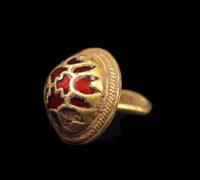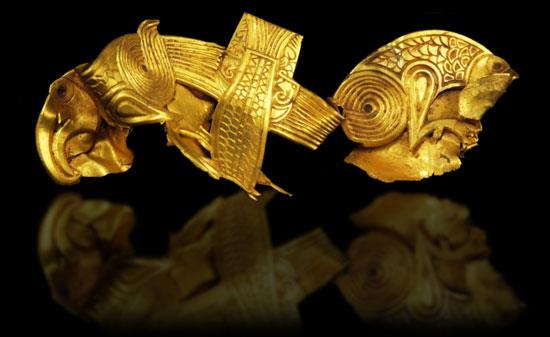






Anglo-Saxon - Identification
Powered By Sispro1

Looking After Your Finds - 2nd Staffordshire Hoard Find
Designed by Nigel G Wilcox
Complimentary Topics
The Paragon Of Metal Detecting
& Archaeology
& Archaeology
Copyright All Rights Reserved by Nigel G Wilcox E-Mail: ngwilcox100@gmail.com
Pages
Anglo-Saxon Finds
Main Coin Menu

Anglo-Saxon Coins
Member NCMD
Anglo-Saxon Menu
Staffordshire Hoard - Case Study
The amateur treasure hunter man who unearthed Britain’s greatest hoard of Anglo Saxon gold with a metal detector bought at a boot sale for £2.50 is to receive a multi-million pound windfall after it was bought for the nation.
The National Heritage Memorial Fund announced today that it is to contribute £1,285,000 of the £3.3 million needed to prevent the hoard of 1,500 gold objects being broken up and sold privately.
The cash will be split equally between the landowner Fred Johnson and Terry Herbert, an unemployed 55-year-old who struck gold when his detector went beep in July 2009.
The find which has become known as the Staffordshire Hoard is the largest collection of Anglo Saxon treasures ever uncovered. It includes enamelled sword fittings, crucifixes and a gold strip with the Latin inscription “Rise up, Lord; may Your enemies be scattered and those who hate You be driven from Your face”. In total the gold objects weighed more than 5kg (11lb).
All the artefacts have a martial connection and are believed to have been stripped from warriors defeated in battle. An inquest declared the hoard to be treasure and the property of the Crown as it had been deliberately concealed. Mr Herbert and Mr Johnson were entitled to receive the full value of the find or it would be returned to their possession.
A deadline of April 17 was set for the money to be raised. The collection was valued by the British Museum. Members of the public have contributed more than £900,000 since the appeal was launched in January and the donation from the National Heritage Memorial Fund, along with contributions from two local authorities made up the balance.
The fund-raising campaign was co-ordinated by the charity the Art Fund. The fund's director, Stephen Deuchar, said: "We have been absolutely bowled over by the enthusiasm and fascination the Staffordshire Hoard has sparked amongst the British public, as well as visitors from abroad.
"It is wonderful news that the National Heritage Memorial Fund has enabled the target of £3.3 million to be reached ahead of the deadline, and I hope that this will give the West Midlands a head-start with the next stage in fundraising for the conservation, research and display of the treasure."
The historian David Starkey who helped launch the campaign said: "This is wonderful news for historians worldwide. The Staffordshire Hoard provides us with vital clues to our ancient past, and now we can set about decoding them.”
Mr Herbet, who found the treasure, was unavailable for comment. After he unearthed it he admitted the find had caused him sleepless nights. He said: “I was gobsmacked. It was unbelievable really. IIn the end I was actually glad to get rid of the objects and see them safely with the archaeologists because once I'd realised the importance of the find they were a real burden to me."
urden to me."
Source: Simon de Bruxelles - The Times 23 March 2010
The National Heritage Memorial Fund announced today that it is to contribute £1,285,000 of the £3.3 million needed to prevent the hoard of 1,500 gold objects being broken up and sold privately.
The cash will be split equally between the landowner Fred Johnson and Terry Herbert, an unemployed 55-year-old who struck gold when his detector went beep in July 2009.
The find which has become known as the Staffordshire Hoard is the largest collection of Anglo Saxon treasures ever uncovered. It includes enamelled sword fittings, crucifixes and a gold strip with the Latin inscription “Rise up, Lord; may Your enemies be scattered and those who hate You be driven from Your face”. In total the gold objects weighed more than 5kg (11lb).
All the artefacts have a martial connection and are believed to have been stripped from warriors defeated in battle. An inquest declared the hoard to be treasure and the property of the Crown as it had been deliberately concealed. Mr Herbert and Mr Johnson were entitled to receive the full value of the find or it would be returned to their possession.
A deadline of April 17 was set for the money to be raised. The collection was valued by the British Museum. Members of the public have contributed more than £900,000 since the appeal was launched in January and the donation from the National Heritage Memorial Fund, along with contributions from two local authorities made up the balance.
The fund-raising campaign was co-ordinated by the charity the Art Fund. The fund's director, Stephen Deuchar, said: "We have been absolutely bowled over by the enthusiasm and fascination the Staffordshire Hoard has sparked amongst the British public, as well as visitors from abroad.
"It is wonderful news that the National Heritage Memorial Fund has enabled the target of £3.3 million to be reached ahead of the deadline, and I hope that this will give the West Midlands a head-start with the next stage in fundraising for the conservation, research and display of the treasure."
The historian David Starkey who helped launch the campaign said: "This is wonderful news for historians worldwide. The Staffordshire Hoard provides us with vital clues to our ancient past, and now we can set about decoding them.”
Mr Herbet, who found the treasure, was unavailable for comment. After he unearthed it he admitted the find had caused him sleepless nights. He said: “I was gobsmacked. It was unbelievable really. IIn the end I was actually glad to get rid of the objects and see them safely with the archaeologists because once I'd realised the importance of the find they were a real burden to me."
urden to me."
Source: Simon de Bruxelles - The Times 23 March 2010



The largest hoard of Anglo Saxon gold ever found, was discovered this summer by a metal-detectorist in a field in Staffordshire and is set to revolutionise our perceptions of life in the 7th and 8th centuries. With more than 650 items made from gold, and more than 500 in silver this is truly a king’s ransom!
Intricately carved with elaborate Anglo-Saxon art styles, some with fine garnet cloisonné, the hoard is not only dazzling but highly intriguing. Most of the objects appear to have been deliberately broken prior to burial and, still more surprisingly, there were no brooches or pendants, no feminine dress fittings; moreover, there were none of the traingular three-rivet gold buckles or any belt fittings so often found in male graves of this period. These intricately decorated and bejewelled finds, martial and masculine in nature, appear to the trophy winnings of a mighty warrior or warriors: hilts from swords or fragments from helmets. Of the 84 sword pommels found, 68 are gold, 11 silver and five are copper alloy or base silver.
Most fragments come from the hilts of swords, pieces of helmets and at least two Christian crosses; five highly unusual and enigmatic small gold snakes were also found, unlike any finds so far discovered.
Source: This comes from Current Archaeology 236, which contains the definitive guide to the Staffordshire Hoard, out on the 1st October.
Staffordshire Hoard
More than just a significant find in terms of monetary value, the Staffordshire hoard lived up to its name.
The largest Anglo-Saxon gold and silver find to this date, it is made up of almost 4,600 items and metal fragments. There is a total of 11lb (5.1 kg) of gold, lots of silver, and 3,500 pieces of jewelry.
They were discovered in a field near Lichfield, England in 2009 and are heralded for the exceptional quality of the workmanship and were purchased for £3.285 million by the Birmingham Museum and Art Gallery and the Potteries Museum & Art Gallery.
More than just a significant find in terms of monetary value, the Staffordshire hoard lived up to its name.
The largest Anglo-Saxon gold and silver find to this date, it is made up of almost 4,600 items and metal fragments. There is a total of 11lb (5.1 kg) of gold, lots of silver, and 3,500 pieces of jewelry.
They were discovered in a field near Lichfield, England in 2009 and are heralded for the exceptional quality of the workmanship and were purchased for £3.285 million by the Birmingham Museum and Art Gallery and the Potteries Museum & Art Gallery.





















